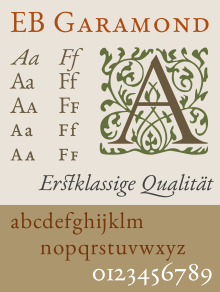Garamond (font)
Garamond is a group of fonts in use since the 16th century , created by or based on Claude Garamond . Garamond used the De Aetna-Type (see also Bembo and Cardo ), which the Venetian Francesco Griffo had created around 1495 for the printer Aldus Manutius , as a basis and weakened its angular serifs . Garamond has excellent reading properties and is still the most commonly used font in letterpress printing .
Nowadays, when Garamond is mentioned, it does not mean a single font, but rather a group of fonts - the fonts of the Garamond type. For a long time it was customary to attribute all good 16th-century French weights to Claude Garamond. Only recent research has shown that many of them do not come from him, but from contemporaries. The best-known example of such a mix-up are the supposedly original Garamond matrices from the inventory of the Imprimerie Royale, shown on the occasion of the Paris World Exhibition in 1900 , which later turned out to be the material of the Sedan type founder Jean Jannon and which were used as models for some of the Garamonds that are still available today.
Until well into the 17th century, new alphabets of the same character appeared again and again, which are now called French Renaissance Antiqua .
Implementations
Practically every major typeface provider has its version of Garamond on offer - often implemented by major typographers of our time (Berthold-Garamond: Günter Gerhard Lange ; Adobe Garamond: Robert Slimbach , Sabon -Antiqua: Jan Tschichold ; Sabon Next: Jean-François Porchez , Amsterdam Garamond: MF Benton / TM Cleland, Garamond Classico: Franko Luin , Simoncini Garamond: Francesco Simoncini, ITC Garamond Handtooled: Edward Benguiat ). Some of the fonts offered as Garamond, however, have little more in common with the model than the name (e.g. Monotype Garamond, based more on the work of Jean Jannon , as well as ITC Garamond, designed by Tony Stan).
In German-speaking countries at least, Stempel Garamond (from D. Stempel AG , now part of the Linotype Library) has the reputation of being the most faithful of the original Garamond. According to information provided by D. Stempel AG, Garamond's original prints were their model. “The new cut of our Garamond, completed in 1925, is based on prints by the stamp cutter, type caster and printer Claude Garamond (1480–1561), from his mature creative years around 1540.” The new cuts published between 1925 and 1932 were made for stamps under the direction of Rudolf Wolf created. The picture on the right shows it above the Adobe version and shows its older form, especially in the "a".
With the digitization of the Stempel Garamond, most ligatures and variations, e.g. B. Lang-s (ſ), & (Et), omitted.
The EB Garamond ( "Egenolff-Berner Garamond") is free software under the SIL Open Font License . This project, started by Georg Duffner, tries to achieve a reproduction of the font weights of Claude Garamont (Antiqua) and Robert Granjon (italics) as true to the original as possible. The basis for this are scans of the Egenolff-Berner typeface sample from 1592. Since this is a joint project, Georg Duffner and numerous other people have also contributed to this implementation, in particular Octavio Pardo, who added the bold fonts. The latest editions of EB Garamond are freely available for embedding in websites on Google Fonts or for downloading as OTF and TTF files in Octavio Pardo's repository.
Preserved original stamps and dies
Some complete sets of original stamps, matrices and casts have survived to this day and are kept in Antwerp's Plantin-Moretus Museum and the Parisian Imprimerie Nationale.
Classification of the script
- According to DIN 16518 , the Garamond belongs to group II ( French Renaissance Antiqua )
- According to the Beinert matrix , it belongs to group 1, subgroup French Renaissance Antiqua
literature
- Ed Cleary, Erik Spiekermann, Jürgen Siebert: Fontbook. 2 volumes. Berlin [Fontshop] 1993 (Volume 1) ISBN 3-930023-00-8 , 1995; (Volume 2), ISBN 3-930023-01-6 .
- Alber Kapr: Calligraphy. History, Anatomy and Beauty of the Latin Letters. KG Saur Verlag, Munich, New York / London / Paris 1983, ISBN 3-598-10463-4
- AF Johnson: Type Designs. London 1959.
- Friedrich Friedl, Nicolaus Ott, Bernhard Stein (eds.): Typography when-who-how, Typographie wann - who - wie, Typographie quand - qui - comment. Könemans, Cologne, 1998, ISBN 3-89508-473-5 .
- Type foundry D. Stempel (Ed.): Old masters of printing. Frankfurt am Main 1940.
- Jan Tschichold: Life and meaning of the type cutter Jakob Sabon. in: Günter Bose, Erich Brinkmann (eds.) Jan Tschichold: Schriften 1925–1974. Two volumes. Volume 2. Berlin 1992 (new edition by Hermann Schmidt Verlag Mainz), ISBN 3-922660-36-3 , pp. 330-335.
- Paul Beaujon [d. i .: Beatrice Warde]: The 1621 Specimen of Jean Jannon, Paris and Sedan, designer and engraver of the charactères de l'Université. London 1927.
- Robert Bringhurst: The Elements of Typographic Style. ISBN 0-88179-205-5 .
- Walter Bergner: Basics of Typography. Fachbuchverlag, Leipzig 1990, ISBN 3-88013-395-6 .
- Anne Cuneo : Garamond's teacher. Complete Paperback edition Munich: Knaur 2006, ISBN 3-426-63268-3 .
Web links
- Overview of the different Garamond fonts , Linotype.com (English)
Footnotes
- ↑ Kay Amert: Stanley Morison's Aldine Hypothesis Revisited . In: Design Issues . 24, No. 2, April 2008, pp. 53-71. doi : 10.1162 / desi.2008.24.2.53 .
- ^ Klopp-Verlag: Die Antiqua ( Memento from December 22, 2014 in the Internet Archive )
- ^ Alfred F. Johnson: Sources Of Roman And Italic Types Used By English Printers In The Sixteenth Century . In: The Library . s4-XVII, No. 1, 1936, pp. 70-82. doi : 10.1093 / library / s4-XVII.1.70 .
- ^ Matthew Carter: Galliard: A Revival of Types of Robert Granjon . In: Visible Language . 19, No. 1, 1985, pp. 77-98. Retrieved May 19, 2017.
- ↑ Sample card index DIN 16507 of D. Stempel AG.
- ↑ Klingspor Museum (PDF).
- ↑ EB Garamond on Google Fonts .
- ^ EB Garamond in the repository of Octavio Pardos.


